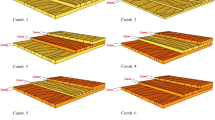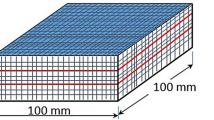Abstract
The objective of this research was to investigate the technical feasibility of producing plywood by green-gluing technology. 2.5 mm thick rotary cut veneers obtained from steamed maritime pine (Pinus pinaster Ait.) logs were used. Plywood was manufactured under vacuum with veneers in a wet state. Five-layer plywood panels were produced using a one-component polyurethane adhesive to evaluate the effects of two parameters, the wood moisture content and the amount of adhesive, on the mechanical properties of plywood. First, a full factorial experimental design was realised to study the bond performance. Shear tests were carried out in order to determine the bond quality and failure type. It was observed that the values of plywood panels’ shear strength depend more on the wood moisture content than on the amount of adhesive applied. A model representing the shear strength of the panels according to the manufacturing parameters was established by using statistical analyses. Another part of this study focused on microscopic observations of the bondline in order to get information about the joint morphology and the degree of adhesive penetration into the wood structure. Results suggested that definite proportions of water (moisture content between 30 and 60 %) and adhesive have to be present on wood surface when gluing to create efficient bonds. These analyses were followed by the panel’s characterisation in flexure to validate the process.





Similar content being viewed by others
References
Bos F (1995) Influence des conditions limites sur la caractérisation mécanique élastique et différée des contreplaqués en flexion (The influence of boundary conditions on the plywood elastic and viscoelastic mechanical characterization during bending) (In French), PhD. Thesis, University of Bordeaux 1, Bordeaux, France
Bos F, Guitard D (1995) Validation expérimentale d’un outil de conception des contreplaqués (Experimental validation of a device for plywood design) (In French). Ann Sci Forestières 52:423–431
Dunky M, Källander B, Properzi M, Richter K, Van Leemput M (2008) Bonding of timber part 2: green gluing. Lignovisionen Issue 18: Core document of the COST Action E34 Bonding of Timber, pp 93–154
Elbez G (2002) Le collage du bois (The gluing of wood) (In French) ISBN 10: 2856840515, CTBA
Gardner DJ (2001) Wood: surface properties and adhesion. Encyclopedia of materials: science and technology. Elsevier, Michigan, pp 9745–9748
Goldman PR (1946) Method of making plywood tubing. Patent 2,411,542
Hass P, Wittel FK, Mendoza M, Stampanoni M, Herrmann HJ, Niemz P (2012) Adhesive penetration in beech wood: experiments. Wood Sci Technol 46(1–3):243–256
Heebink BG (1953) Fluid pressure moulding of plywood. Technical Report 1624, U. S. Department of Agriculture, Forest Service, Forest Products Laboratory, Madison 5, Wisconsin
Johnson SE, Kamke FA (1992) Quantitative analysis of gross adhesive penetration in wood using fluorescence microscopy. J Adhes 40:47–61
Kamke FA, Lee JN (2007) Adhesive penetration in wood—a review. Wood Fiber Sci 39(2):205–220
Karastergiou S, Mantanis GI, Skoularakos K (2008) Green gluing of oak wood (Quercus conferta L.) with a one component polyurethane adhesive. Wood Mater Sci Eng 3(4):79–82
Louvet F, Delplanque L (2005) Les plans d’expérience: une approche pragmatique et illustrée (Experimental designs: an illustrated and pragmatic approach) (In French). Association Expérimentique, Orléans
Meynis de Paulin JJ (ed) (1977), Les colles et adhésifs et leurs emplois industriels. II-Les matières premières (Glues and adhesives and their industrial applications—II-Raw materials), (In French), vol Tome 2. G. Le Prat, Paris
Morlier P, De Jeso B, Daude G, Dimier G (2002) Composition adhésive pour matériau humide (Adhesive composition for wet material). (In French), Patent 2 842 818
NF EN 14358 (2007) Structures en bois: Détermination des valeurs correspondant au fractile à 5% d’acceptation pour un échantillon (Timber structures—calculation of characteristic 5-percentile values and acceptance criteria for a sample), AFNOR
NF EN 314 (1993) Contreplaqué: Qualité du collage (Plywood: bonding quality), AFNOR
Ngo D, Pfeiffer E (2003) The art of plywood furniture. Princeton Architectural Press, New York
Parker JR (1994) Greenweld process for engineered wood products. In: The international panel and engineering wood technology exposition, Atlanta, GA, USA
Pommier R, Elbez G (2006) Finger-jointing green softwood: evaluation of the interaction between polyurethane adhesive and wood. Wood Mat Sci Eng 1(3–4):127–137
Pommier R, Grimaud G, Prinçaud M, Perry N, Sonnemann G (2015) Comparative environmental assessment of materials in wooden boat ecodesign. Int J Life Cycle Assess 21(2):265–275
Ren D (2010) Moisture-cure polyurethane wood adhesives: wood/adhesive interactions and weather durability. PhD Thesis, Virginia Polytechnic Institute and State University, Virginia, USA
Rolpin (2014) Technical report—batipin. http://ks22949.kimsufi.com/~rolpin/images/PDF/Fiches_techniques/fiche%20technique%20rolpin%20bati.pdf
Sterley M, Trey S, Lundevall A, Olsson S (2012) Influence of cure conditions on the properties of a one-component moisture-cured polyurethane adhesive in the context of green gluing of wood. J Appl Polym Sci 126(SUPPL. 1):E296–E303
Strickler MD (1970) End gluing of green lumber. For Prod J 20(9):47–51
Kriebich RE, Steynberg PJ, Hemingway R (1997) End jointing green lumber with SoyBond. In: Swanson JS (ed) Proceedings 2nd biennial residual wood conference, wood residues into revenue. Richmond, BC, MCTI Communications, Inc. pp 28–36
Serrano E, Oscarsson J, Enquist B, Sterley M, Petersson H, Källsner B (2010) Green glued laminated beams—high performance and added value. In: Proceedings (Poster session) of 11th world conference on timber engineering, Riva Del Garda, Italy pp 829–830
Acknowledgments
The authors are grateful to the ANRT (National Agency for Research and Technology) for funding the project, to the competitiveness Cluster ABOVE for supplying wood raw material, XYLOPLATE of XYLOFOREST EquipEx (ANR-10-EQPX-16). We owe special thanks to Aalto University for their scientific support.
Author information
Authors and Affiliations
Corresponding author
Rights and permissions
About this article
Cite this article
Lavalette, A., Cointe, A., Pommier, R. et al. Experimental design to determine the manufacturing parameters of a green-glued plywood panel. Eur. J. Wood Prod. 74, 543–551 (2016). https://doi.org/10.1007/s00107-016-1015-4
Received:
Published:
Issue Date:
DOI: https://doi.org/10.1007/s00107-016-1015-4




